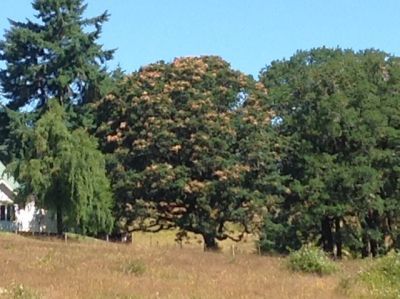
Publisher:
Bonnie King
CONTACT:
Newsroom@Salem-news.com
Advertising:
Adsales@Salem-news.com

~Truth~
~Justice~
~Peace~
TJP
Jul-24-2014 15:42

 TweetFollow @OregonNews
TweetFollow @OregonNews
Wasps, Squirrels Damaging Oregon White Oak Trees
Salem-News.com Staff"The damage to these trees seems to be common around the Willamette Valley," says ODF Forest Pathologist Alan Kanaskie.
 Recently, stewardship foresters with the Oregon Department of Forestry have been receiving phone calls from landowners, homeowners and other members of the public concerned about the appearance of numerous dead branches and leaves on Oregon white oak trees. Photo Courtesy: Oregon Department of Forestry |
(SALEM, Ore. ) - Recently, stewardship foresters with the Oregon Department of Forestry have been receiving phone calls from landowners, homeowners and other members of the public concerned about the appearance of numerous dead branches and leaves on Oregon white oak trees.
Investigation by agency foresters resulted in the discovery that the damage is being caused by both insects and mammals.
"From the examples we've seen, it seems to be caused by a combination of gall wasps and damage from western gray squirrels who chew or strip off the bark of the trees in an attempt to feed on the wasp's larvae located underneath," says Rob Flowers, Entomologist with the Oregon Department of Forestry.
"The damage to these trees seems to be common around the Willamette Valley," says ODF Forest Pathologist Alan Kanaskie, "it was particularly severe a few years ago, as well."
The gall wasp, Bassettia ligni (Family Cynipidae) is a wasp specific to the oaks. During the early stage of their life cycle, wasp larvae live inside the galls, typically causing the swelling of the branches and bark-splitting, as well.
In addition to the direct impact of the wasps, the chewing and stripping of the infested branches by squirrels is very common. Gall wasp larvae happen to be a favorite food for squirrels who utilize the insects for protein stores. As squirrels chew the branches containing galls, the removal of bark causes the branch beyond that point to die, and the leaves turn tan to reddish-brown.
Foresters are advising the public that the "branch dieback" currently being observed on Oregon White Oaks around the Willamette Valley is short-lived, and most trees don't suffer from any significant long-term health consequences.
If you have questions or concerns about insect, disease or animal damage to oak trees on your property, please contact a Stewardship Forester at ODF's Molalla or Dallas offices or at the ODF office nearest you.
Source: Oregon Department of Forestry
 |
Articles for July 23, 2014 | Articles for July 24, 2014 | Articles for July 25, 2014
Quick Links
DINING
Willamette UniversityGoudy Commons Cafe
Dine on the Queen
Willamette Queen Sternwheeler
MUST SEE SALEM
Oregon Capitol ToursCapitol History Gateway
Willamette River Ride
Willamette Queen Sternwheeler
Historic Home Tours:
Deepwood Museum
The Bush House
Gaiety Hollow Garden
AUCTIONS - APPRAISALS
Auction Masters & AppraisalsCONSTRUCTION SERVICES
Roofing and ContractingSheridan, Ore.
ONLINE SHOPPING
Special Occasion DressesAdvertise with Salem-News
Contact:AdSales@Salem-News.com

googlec507860f6901db00.html



Terms of Service | Privacy Policy
All comments and messages are approved by people and self promotional links or unacceptable comments are denied.
[Return to Top]
©2025 Salem-News.com. All opinions expressed in this article are those of the author and do not necessarily reflect those of Salem-News.com.